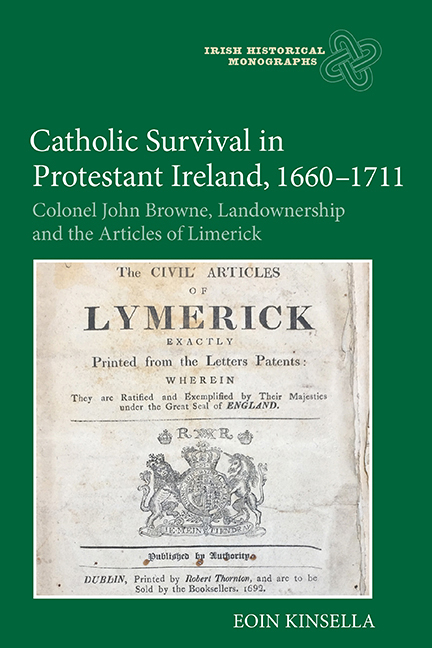 Catholic Survival in Protestant Ireland, 1660–1711
Catholic Survival in Protestant Ireland, 1660–1711 Book contents
- Frontmatter
- Dedication
- Contents
- List of Illustrations
- Acknowledgements
- List of Abbreviations
- Editorial Note
- Glossary
- Introduction
- Part I The Rise and Fall of the ‘New Interest’
- 1 ‘I hope all will end well with our New Interests’: The rise and fall of a ‘new interest’ landowner, 1666–89
- 2 ‘You must engage your plate, your credit, and all is at stake’: Jacobite colonel, ironmaster and negotiator, 1689–91
- Part II The Articles of Surrender
- Part III Article 13 of Limerick
- Conclusion
- Appendix A Articles of Surrender, 1690–91
- Appendix B Hearings scheduled for adjudication under the articles of Limerick, 1694
- Appendix C Proclamations of 7 July & 1 August 1691; ‘A copy of and answers to several complaints made by the Irish by their agent Mr Cockly’
- Bibliography
- Index
1 - ‘I hope all will end well with our New Interests’: The rise and fall of a ‘new interest’ landowner, 1666–89
from Part I - The Rise and Fall of the ‘New Interest’
Published online by Cambridge University Press: 28 June 2018
- Frontmatter
- Dedication
- Contents
- List of Illustrations
- Acknowledgements
- List of Abbreviations
- Editorial Note
- Glossary
- Introduction
- Part I The Rise and Fall of the ‘New Interest’
- 1 ‘I hope all will end well with our New Interests’: The rise and fall of a ‘new interest’ landowner, 1666–89
- 2 ‘You must engage your plate, your credit, and all is at stake’: Jacobite colonel, ironmaster and negotiator, 1689–91
- Part II The Articles of Surrender
- Part III Article 13 of Limerick
- Conclusion
- Appendix A Articles of Surrender, 1690–91
- Appendix B Hearings scheduled for adjudication under the articles of Limerick, 1694
- Appendix C Proclamations of 7 July & 1 August 1691; ‘A copy of and answers to several complaints made by the Irish by their agent Mr Cockly’
- Bibliography
- Index
Summary
John Browne of Westport, County Mayo, was the quintessential representative of the Catholic ‘new interest’. Called to the Irish bar in 1669, he was a self-made man. As one of the greatest beneficiaries of the upheaval caused by the Restoration land settlement, between 1666 and 1685 Browne accrued an enormous estate in Galway and Mayo of more than 155,000 acres (with over 39,000 acres classed as profitable), as well as property in Counties Sligo, Roscommon, Clare and Dublin. He was an ambitious man who used family connections to great advantage. Married to a daughter of the 3rd Viscount Mayo, Browne was also linked by his siblings’ marriages to several prominent families, both Catholic and Protestant, including the Dillons of Roscommon, the Malones of Westmeath, the Binghams of Mayo and the Talbots of Dublin. At least one of his nephews, George Browne, was commissioned in the regiment John raised for James II in 1689. Two other nephews were prominent lawyers: Garrett Dillon in the reign of James II, and Edmund Malone from the 1680s until the 1720s. Both were intimately acquainted with Browne's financial affairs – Dillon became a business partner with his uncle in the 1680s, while Malone proved an important lobbyist for Browne and others in Dublin and London during the 1690s and beyond.
During the Williamite war Browne established himself as one of the most important Irish Jacobites and acted as a negotiator and signatory of the articles of Limerick. He used this position to secure a controversial article, which ensured that liability for his personal debts – at least £30,000, incurred before the outbreak of the war and owed mostly to Irish Protestants – was not to be borne by him alone, but shared with all Catholics who retained their land under the various articles of surrender. Nonetheless, the settlement of these debts eventually stripped Browne of almost his entire estate, a process that took more than two decades and was still not complete at the time of his death.
This chapter surveys Browne's rise to prominence as a landowner and lawyer, and his attempts to establish himself as an ironmaster. As with many of his ‘new interest’ contemporaries, Browne's training at the inns of court in London equipped him to explore opportunities for investment in land.
- Type
- Chapter
- Information
- Catholic Survival in Protestant Ireland, 1660–1711Colonel John Browne, Landownership and the Articles of Limerick, pp. 17 - 40Publisher: Boydell & BrewerPrint publication year: 2018
